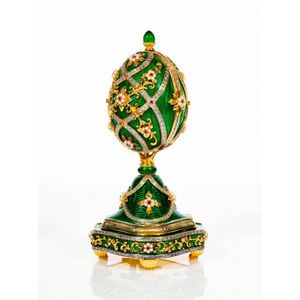19th Century English Rococo Potpourri Vases with Figural Finials
You must be a subscriber, and be logged in to view price and dealer details.
Subscribe Now to view actual auction price for this item
When you subscribe, you have the option of setting the currency in which to display prices to $Au, $US, $NZ or Stg.
- Gilding - Gilding is a method of ornamentation whereby a thin sheet of gold metal is applied to items made of wood, leather, ceramics, glass and silver for decorative purposes.
For furniture including mirrors, the sheet of gold is usually applied over a coating of gesso. Gesso is a mixture of plaster of Paris and gypsum mixed with water and then applied to the carved wooden frames of mirrors and picture frames as a base for applying the gold leaf. After numerous coats of gesso have been applied, allowed to dry and then sanded a coat of "bole", a usually red coloured mixture of clay and glue is brushed on and allowed to dry, after which the gold leaf is applied. Over time parts of the gilding will rub off so the base colour can be seen. In water gilding, this was generally a blue colour, while in oil gilding, the under layer was often yellow. In Victorian times, gilders frequently used red as a pigment beneath the gold leaf.
Metal was often gilded by a process known as fire gilding. Gold mixed with mercury was applied and heated, causing the mercury to evaporate, the long-term effect of which was to kill or disable the craftsman or woman from mercury poisoning. The pursuit of beauty has claimed many victims, not the least of which were the artists who made those pieces so highly sought after today. - Finial - An architectural decoration, found on the upper parts of of an object. On furniture they are usually found on pediments, canopies and shelf supports. On smaller ceramic or silver items, such as spoons, they may decorate the top of the item itself, or the lid or cover where they provide a useful handle for removal.
Finials have a variety of shapes and forms. They may be urn-shaped, baluster shaped round or spiral, but usually taper into an upper point. Many real life shapes may also be used as finials, such as pineapples, berries, pinecones, buds, lotus and acorns. Sometimes animals such as a lion are depicted, or fish and dolphins.
This item has been included into following indexes:
- Coalport and Coalbrookdale porcelain (England) - ceramics 528
- Coalport porcelain (England), item type
Visually similar items

A Cown Devon Fieldings lustre ware dish, with hand painted & gilt detail, 24 cm

A Coalport vase with cover, circa 1830 the urn shaped vase finely painted with floral sprigs and applied spring flowers throughout, the pieced cover similarly decorated with a carnation floral finial, 28 cm high. Provenance: David Roche collection. Adelaid

Diamond and gem set pendant/brooch, of giardinetto design, the bulbous vase decorated with fluted citrine, onyx and circular-cut diamonds, the floral arrangement highlighted with pearls and multi-coloured carved gemstones, mounted in 18ct gold, length appr

House of Faberge 'Garden of Jewels' Imperial musical egg crafted in green guilloche enamelled sterling silver, highlighted in 24ct gold, set with 32 rubies, 155 cultured pearls and amethysts, playing Mozart's Magic flute, limited edition. Height 20 cm
